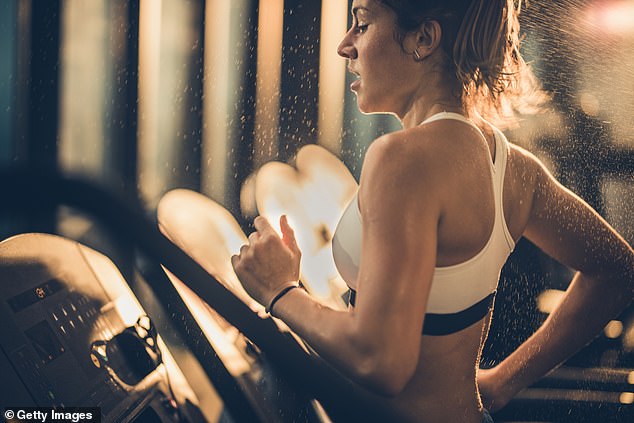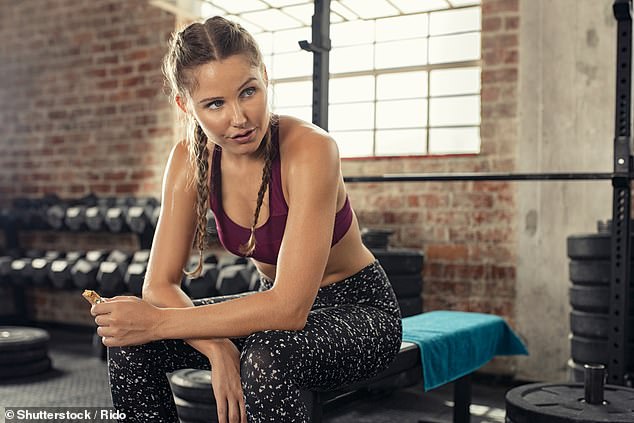Women with large busts may sweat less than their counterparts with smaller breasts, a British sports scientist has found.
Researchers found that the density of sweat glands reduces according to breast size, which is likely why women with large breasts produce less moisture.
Meanwhile, less endowed women sweated more in the chest area, the study revealed.
The researchers said their findings help inform the design of sports bras for women of all sizes. It better addressed “wetness, stickiness, support and rubbing” to stay comfortable.
To test their theories, scientists at the University of Southampton studied 22 healthy women aged between 18 and 55 with breasts of different sizes.
They found that women with the smallest breasts had up to 71 sweat glands per square centimeter, while those with the largest breasts had as few as 10 glands in the same area.
Researcher Hannah Blount said: “More than 85 per cent of women consider a sports bra to be essential exercise equipment, but it is actually very difficult to find one that is comfortable and supportive, so many women struggle with this”.
“Our thought process was to look at how sports bras offer support for women and comfort for women of different breast sizes, especially in hot conditions, when women are more likely to experience problems such as chafing and significant sweat buildup on the breasts. the Bra.
“Specifically, we were interested in understanding how sweat gland densities and local sweat rates change in women of different breast sizes, as that determines the amount of sweat that ends up in the sports bra.
“Here we got the most interesting finding, as our results indicated that women with larger breasts have fewer sweat glands and therefore produce less sweat in their breasts.
“This fundamental knowledge is something we can now use to inform the design of sportswear that takes into account the needs of women of different breast sizes.”

New sweat glands stop developing in the human body after two years. As a girl’s breasts develop during puberty, the sweat glands become less densely packed on the surface of her skin.
She added: “We are becoming more sedentary as a society, so if we can do something to help women be more active and at the same time make sport more accessible, then that will be really exciting.”
The body stops developing new glands at approximately two years of age.
The researchers said that as a girl’s breasts develop during puberty, the sweat glands become less densely packed on the surface of her skin.
They also found that sweat glands do not produce more sweat when they are less numerous, meaning that larger breasts produce less sweat overall.
Each of the 22 women in the study was asked to jog for 45 minutes in a warm climate chamber at 32°C.
The amount of sweat they produced on their breasts was monitored in two places, above and below the nipple, and thermal cameras were used to see how much heat their bodies produced during exercise.
Sweat production under the arms was also monitored.
A 3D scan was used to calculate breast surface area, while sweat gland density was measured using iodine paper which, when placed on the skin, reacts with chemicals in sweat.
Women with larger busts sweated less in the breast area, but the researchers found no clear differences in the amount of sweat produced under the arms, breasts, or body temperature between women with larger and smaller breasts.
The experiments were carried out in ThermosenseLab’s state-of-the-art climate chamber, at the NIHR (National Institute for Health and Care Research), University Hospital Southampton.
Dr. Davide Filingeri, a leading expert in human skin moisture sensing, said: “Women experience unique anatomical, physiological and hormonal changes throughout their lives.
‘Consider the impact of the menstrual cycle, pregnancy and menopause, all of which impact a woman’s heat tolerance, thermal sensitivity and comfort.
“As such, Hannah’s research into the unique and evolving “thermal needs” of women’s bodies has the potential to inform person-centered innovation in activewear, which will ultimately help women thrive in our increasingly warm climate.
The study, published in the journal Experimental Physiology, states that the number of women practicing sports has increased considerably in the last 50 years, and data indicates that almost 50 percent of women worldwide are now interested in the sport. sport.
But the lack of appropriate clothing can be a barrier for many women to play sports.
While sports bras that expose more skin may allow the breasts to radiate more heat, this may reduce their effectiveness in providing needed support.


